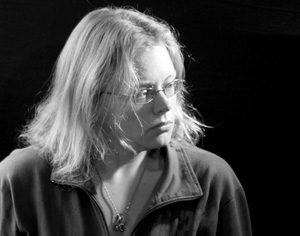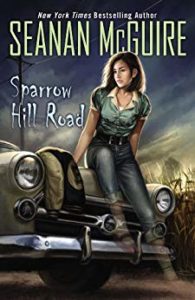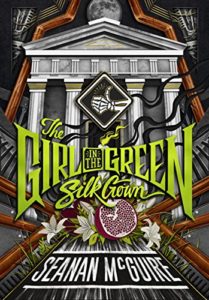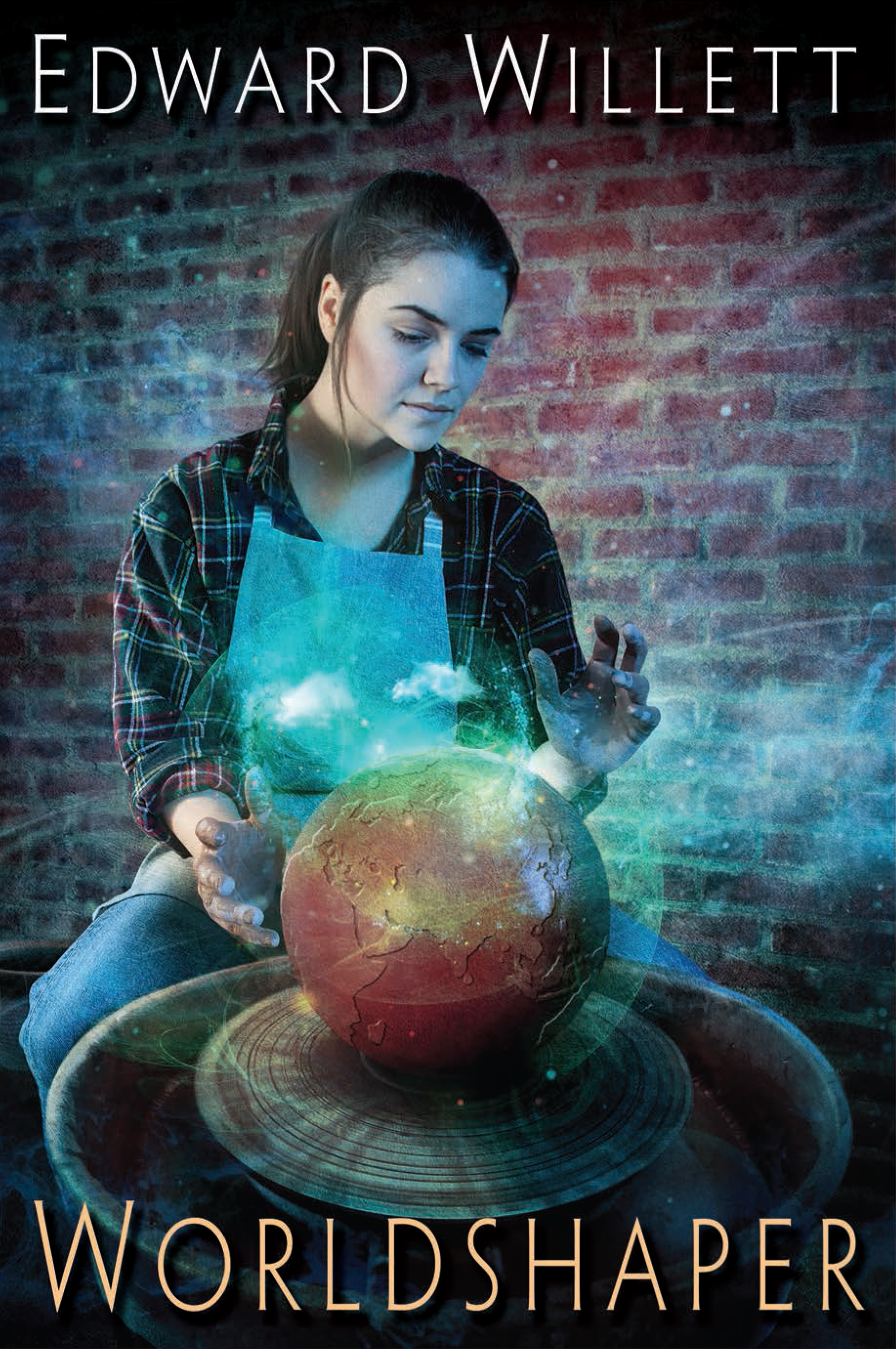Podcast: Play in new window | Download | Embed
Subscribe: Apple Podcasts | Spotify | Amazon Music | Email | TuneIn | RSS | More
An hour-long conversation with Seanan McGuire, Campbell, Hugo, and Nebula Award-winning author of more than twenty books in various series, including the bestselling October Daye and InCryptid series, with a special focus on the first two books in her Ghost Roads series featuring the hitchchiking ghost Rose Marshall, Sparrow Hill Road and The Girl in the Green Silk Gown, published by DAW Books. Seanan also writes biomedical science fiction thrillers as Mira Grant.
Websites:
seananmcguire.com
miragrant.com
Twitter:
@SeananMcGuire
Patreon:
Seanan McGuire
The Introduction
 Seanan McGuire was born in Martinez, California, and raised in a wide variety of locations, most of which boasted some sort of dangerous native wildlife. Despite her almost magnetic attraction to anything venomous, she somehow managed to survive long enough to acquire a typewriter, a reasonable grasp of the English language, and the desire to combine the two.
Seanan McGuire was born in Martinez, California, and raised in a wide variety of locations, most of which boasted some sort of dangerous native wildlife. Despite her almost magnetic attraction to anything venomous, she somehow managed to survive long enough to acquire a typewriter, a reasonable grasp of the English language, and the desire to combine the two.
Seanan is the author of the October Daye urban fantasies, the InCryptid urban fantasies, and several other works, both stand-alone and in trilogies or duologies. She also writes under the pseudonym “Mira Grant.”
In her spare time, Seanan records CDs of her original filk music. She is also a cartoonist, and draws an irregularly posted autobiographical web comic, “With Friends Like These…”.
Seanan was the winner of the 2010 John W. Campbell Award for Best New Writer, and her novel Feed (as Mira Grant) was named as one of Publishers Weekly’s Best Books of 2010. In 2013 she became the first person ever to appear five times on the same Hugo Ballot. Her novella “Every Heart A Doorway” received the 2016 Nebula Award for Best Novella, the 2017 Hugo Award for Best Novella, and the 2017 Locus Award for Best Novella.
Seanan lives in an “idiosyncratically designed” labyrinth in the Pacific Northwest, which she shares with her cats, a vast collection of creepy dolls and horror movies, and, she says, sufficient books to qualify her as a fire hazard.
The Show
First, we note we share an editor (Hugo Award-winning Sheila E. Gilbert) and publisher (DAW Books), but haven’t chatted much until now.
Seanan says her interest in writing “just happened”—she actually got a prescription for a typewriter as small child because she was giving herself migraines trying to write faster than she could. She says her mother associated her not being dead with the sound of the manual typewriter banging, usually around 3 a.m.,” and adds, “it’s kind of a wonder my mother did not drown me in the nearest creek.”
Her interest in writing stories (as opposed to just writing everything down) arose when she discovered that was something people could do. She recalls a show on USA Network, Ray Bradbury Presents, which featured Bradbury presenting stories, some based on his work, some on others. Every episode began with a man at a typewriter, pulling out a sheet of paper out and throwing it into the air. That paper would become the logo, and then the show would start. This annoyed Seanan because of they’d taken out the credits they’d have had thirty more seconds for stories.
Her grandmother explained the man was Ray Bradbury, who had written the stories, and so they’d let him do whatever he wanted. Until then, Seanan had never imagined that people were allowed to make up stories: for her, creating stories was almost holy. It seemed to her that for someone to be an author, a person who is the reason a story exists in the world, there should at least be an entrance exam. (There isn’t.) Upon learning that was an option, she was very firm (at age six) that this was what she was going to do.
Seanan grew up in the Concord, CA, area, a semi-rural suburb in the San Francisco Bay area. She wrote a lot of fan fiction as she grew older, “some of which was terrible, some of which quite good for a six, seven, eight years old.” She started writing her own original stories in middle school, and once she started, she said, it was hard to make her stop, even though other kids mocked her for it. “I am a perpetual motion machine of irritation.”
She wrote her first novel when she was twelve, about 60,00 words long. “It will never see the light of day.”
Seanan is also a singer/songwriter. That also began in childhood. “All little kids are singers, most are songwriters,” she says. “They make up songs all the time.” The earliest song she knows existed of her was a dishwasher-loading song, to help her remember where things went.
“It gets beaten out of you at some point,” she says. “People laugh, and humans are susceptible to mockery. We don’t like it, as a general rule. I had a very poor sense of whether I was being laughed at, so I merrily bumbled through.”
In third grade, she discovered she could make money entering poetry and songwriting competitions—very helpful, because she grew up very poor. “Finding out I could win $30 for writing a song was like free money.” The money she earned that way paid a decent number of school supply bills.
Seanan is a cartoonist, as well (“not great, but I enjoy it”). That, too, began in childhood: all children are artists, she notes.
All children are also interested in the fantastical, so it’s not surprising she started writing it. After all, she says, “Ninety percent of all children’s media is fantastical.” Her first fandom was My Little Pony, which, she notes, “is the story of a matriarchal world where talking unicorns rule the day. It’s hard to get much more fantastic than the things we hand to kids and tell them, this is normal.”
As a result, she says, “I was just writing in the spaces I had been told were mine to inhabit. I never left them.”
Seanan majored in folklore and herpetology in university. She kept writing, but she didn’t take any creative writing classes: in high school because she couldn’t afford them, and in college because she didn’t have time for elective courses that didn’t connect to one of her two majors, and as well, she lacked the prerequisite high school courses.
Her folklore major continues to play a huge role in her writing. “I write fairy tales now,” she notes. She’s amassed a huge folklore library of her own. “The biggest advantage is, I know what I’m looking for.”
Around 2002, she finished the first October Daye book, the first thing she’d finished she thought someone else might want to read, and began trying to sell it. It didn’t find a home until DAW picked it up in 2008.
But she’d been writing a lot before she was trying to sell, in the “fan fiction mines.” She wrote huge quantities of fan fiction, which people read and gave feedback on. This helped her learn a lot of useful things, such as how to take critiques, and that even if a story is “practically perfect in every way,” there are going to be people who don’t like it.
There is a strong tradition of beta readers in fan fiction. Many of hers from those days are still with her, beta reading the October Daye books before they go to DAW, which she finds “soothing,” since “I want to look perfect all the time.”
DAW was a good choice for the October Daye books for a couple of reasons. One was that DAW has a reputation for keeping all the books in an ongoing series in print, which would be important for a series as long as Seanan hoped this one would be.
As well, Tanya Huff, another DAW author and a good friend of Seanan’s, told her Sheila, who is also Tanya’s editor, was someone Seanan would be able to work with well.
Sure enough, DAW took the book, launching Seanan’s career. “Tanya was correct, DAW was a good fit for me.”
Seanan also writes as Mira Grant. (She won’t say where the pseudonym came from because “it’s a complicated horror movie joke that no one has managed to decode. Someone somewhere will get to feel very clever someday…”)
Seanan says under her own name she writes fantasy and some fantastic horror, whereas Mira writes biomedical science fiction thrillers. For Seanan, “all that matters is the nightmare.” But everything Mira writes is grounded in scientific fact. “I will generally allow Mira a single point of scientific implausibility,” Seanan says. “Everything else drawn from rigorous scientific study and research.”
How rigorous? For the parasitology series, about genetically engineered tapeworms and the frailties of the modern medical system, she spoke to multiple paristologists from multiple countries, studied up on the hygiene hypothesis, and even infected herself with a goat tapeworm for eighteen months so she could accurately document the sensation of having a tapeworm moving through her body. “That was Timmy. I miss Timmy. He’s not with us anymore.”
Mira Grant has to have a level of plausibility in her writing that Seanan doesn’t have to have in hers. Seanan says she’s far creepier at fewer than about eighty pages because she doesn’t have to set up the scientific underpinnings.
She’s so careful with scientific accuracy with Mira partially because she loves to “wallow” in these topics, but also partially because of sexism. “When you’re writing hard science fiction as a female-presenting author have to be twice as rigorous as your male peers,” she says. She notes she’s been on panels were men were applauded when they said they didn’t do any research, they just made things up, right before the women, herself included, were interrogated on a simple error that wasn’t incorrect at the time of the books’ writing. “Mira,” Seanan says, “is writing in a part of the genre where women are still asked to justify our existence.”
 Seanan synopsizes the Rose Marshall books, Sparrow Hill Roadand The Girl in the Green Silk Gown, this way:
Seanan synopsizes the Rose Marshall books, Sparrow Hill Roadand The Girl in the Green Silk Gown, this way:
Rose Marshall is a hitchhiking ghost who died in the 1950s, run off the road on her way to her senior prom. She has continued her existence, if not her life, and is constantly grappling with the folk process: because she is a hitchhiking ghost, people tell her story in different ways, some of which she doesn’t really approve of very much. She moves along the ghost roads, in the eternal twilight underneath our daylight realms, trying to  both avoid and destroy Bobby Cross, who ran her off the road and is a danger to both herself and other ghosts, who don’t want to do any harm to anyone.
both avoid and destroy Bobby Cross, who ran her off the road and is a danger to both herself and other ghosts, who don’t want to do any harm to anyone.
Seana says Rose started as a non-player character in a 1950s supernatural game, Martin’s Passage. A friend asked her to come in and play a hitchhiking ghost for a short time for the storyline he was running. He left her creation up to Seanan, and she “just refused to give her back.”
Next, Rose became a song, “Pretty Little Dead Girl.” Seanan was already starting to play with the idea that Rose would let her experiment with the folk process. That song is the “filthy libel” version of Rose’s story, in which she’s a murderer intentionally driving motorists to her death.
Seanan wrote many more songs, each casting Rose in a different light; then Jennifer Brozek, editor of an online magazine called The Edge of Propinquity, asked her to tell the story of what really happened. Every month for a year she wrote a short story telling the truth about Rose. At the end of the year, DAW agreed to publish them as a “fix-up novel.” The Girl in the Green Silk Gownfollowed this year.
Seanan has recorded many of the songs, but the CD is currently out of print, so they’re very hard to find. She’s written a few more, but finds it hard to write the songs when she’s working with Rose in the long form, because the character is so “awake” that settling her down to intentionally tell lies about her is complicated.
Writing songs and poetry and writing books are very different, Seanan says. Songs and poetry are “linguistically heightened” form of storytelling, where you have to “turn everything up to 11” because you’re trying to make your point in such a compressed space.
Word choice is more important in songs, and the narrative beats are different. “It doesn’t make one better or worse than the other.”
The songs helped her develop the world, because they establish that within the context of the world, Rose is a story everyone has heard; everyone feels they have a relationship with her because they heard some version of her story around a campfire when they were eight.
To develop any fictional world, Seanan says, you need to figure out what you need to do: what story are you trying to tell, and what structure does the world you are putting together have to have to be able to stand up to and support that story?
Rose is a hitchhiker ghost, which have existed all throughout history—but she’s a North American hitchhiker ghost, which is unlike those anywhere else. So Seanan did a lot of research into hitchhiker ghosts. “Academic accuracy is important to me even if no one else cares.”
Then she had to set the rules of how ghosts became hitchhiker ghosts. She asked herself a lot of questions to pin everything down. “You just keep drilling down until you have a structure that can support what you need.”
On the other hand, she doesn’t lock everything down, so she has space to do other things she might need to do as the story progresses. She compares it to a really big, slow-moving game of improv, where you always have to be prepared to say, “Yes, and…”
Just as important as the rules are the exceptions. If there are no exceptions to the rules, the world is too rigid. If there are too many, the world is too loose.
Seanan starts with a synopsis of a page or two, but she does her best work when there’s a certain amount of fluidity involved: if the story is locked down too firmly, she feels she’s already told it and loses interest.
Characters do occasionally pop into existence as she’s writing, and become unexpectedly important, but so far that hasn’t happened in this series. “Everyone is very well-behaved,” shje says.
Rose is both an eternal teenager and very old; a hard balance to hit, Seanan says. Her setting makes being dead kind of a party, so she needed to be sure there were costs to continued existence, reasons Rose had to mourn her life. One reason is that ghosts don’t change, so Rose is always going to be a teenager, a little bit insecure, and lacking the emotional depth she would have been able to develop if she had lived. She doesn’t have great coping skills (neither did Seanan when she was a teen: she says Rose “is a disaster, and I love her”). Yet, Rose has seen a lot of stuff in the decades since she died, and she can’t completely cut that off. She finds actual teenagers exhausting, but wants their approval, as well. She is increasingly a girl out of time.
Seanan says some of her books are remarkably clean at the end of the first draft, so much so she feels like she slept through the writing of the second draft. Others are “a hot buttered mess.” One step all books go through is a complete retype, even though she works on a computer. She begins on page one and retypes the entire book. “It enables me to reassess every single word I’ve chose. I don’t recommend it unless you type really fast.”
She always runs her books past her beta readers. Some have been with her as long as twenty years. She calls them the “Machete Squad,” and each has his or her on specialty, from grammar to blocking to continuity.
Sheila Gilbert at DAW then reads the book and provides note. “Either I argue with her, which enables me to refine my understanding, or she’s correct, and when she’s correct I make those changes. She’s been doing this a really long time, she knows some ways better than I do what the market looks like.”
Seanan is prolific, always juggling multiple projects. Part of it is that she doesn’t sleep enough, she says, but as well, she made life choices that support working the way she does. She says whenever someone says you can have it all without giving something up, they haven’t stopped and assessed what they did and didn’t give up. She notes that she’s unmarried, and lives in a house in the Pacific Northwest with two housemates, to make sure she has money coming in from the rental of their rooms. She doesn’t have children. She didn’t make that choice for her writing career but because she didn’t think she’d be a very good parent, but if she had them, she’d have to wonder if she could support them since they would have an impact on her writing time, and that’s the source of her income. She says she doesn’t regret her choices, but it’s disingenuous to pretend they haven’t had an influence.
“You can be a full-time parent and write, I just don’t think you can write as much as I do until your kids are a little older.”
Why does she write?
“If I don’t, I go slowly out of my mind…I write because I don’t have a choice. I write stories of the fantastic because those are the stories I fell in love with and I decided that was the genre I was too stubborn to give up on. I write because if I didn’t, I’d probably be dead.”
Asked if she hopes her writing helps shape the real world, she says, “I do. Not to get political, but Terry Pratchett referred to humanity as the storytelling ape. We shape and reshape our world by telling stories both to ourselves and each other. We point to an open plain and say, what if there was a city there, let me tell you the story of the city there. We point to a disease and say, what if children didn’t have to die of this disease, let me tell you a story about a treatment, and we chase those stories and we bring them into being because that is what it means to be human.
“There is a profound alienation in not seeing yourself in story, in being presented with story after story, after world after world, where only certain kinds of people are good enough to be heroes, where only certain relationships are considered clean enough to hold up to children. If every time you paint me you paint me as a villain, eventually I’m going to start to think of myself as villainous. And that’s why we need diverse voices writing and that’s why we need diverse stories being told, and that’s why, frankly, no matter what demographic we personally fit into, we need to be including characters and people who aren’t exactly like us, because if we don’t see someone in a story, a part of us doesn’t know how to see them as human. So the way I would like to shape the world is the way I think every storyteller shapes the world. I want to shape the world by saying, “This is what humanity looks like.” But I want to be one of the people that’s holding up as wide a mirror as possible, and reflecting as much of humanity as possible, so that when I say, this is what it’s like to be human, I’m not saying, only this one small kind of person is human, I’m saying everybody is, and maybe could we just stop being assholes to each other for one goddamn minute.”
